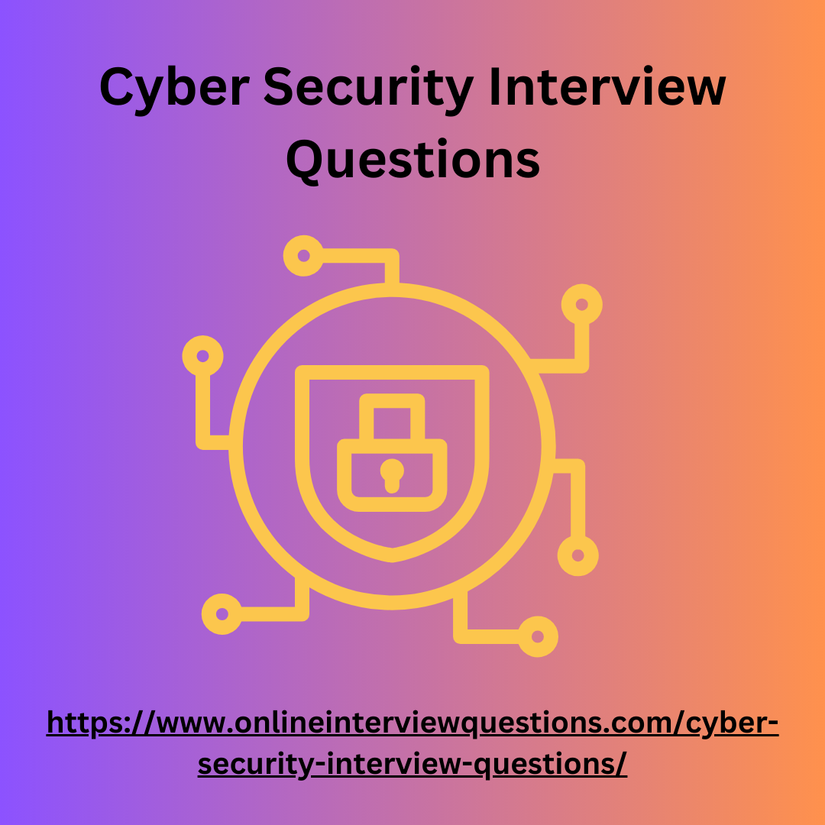Top 20 Cyber Security Interview Questions and Answers
Cybersecurity professionals are in high demand to safeguard digital assets against ever-growing threats. Whether you’re a seasoned expert or a fresher entering the field, preparing for a cybersecurity interview requires a thorough understanding of core concepts and practical knowledge. We offer Top 30 Cyber Security Interview Questions and Answers in below:

Q1. What is cybersecurity?
Ans: Cybersecurity is the practice of protecting computer systems, networks, and data from unauthorized access, cyber-attacks, and data breaches.
Q2. What is the CIA triad?
Ans: The CIA triad stands for Confidentiality, Integrity, and Availability. It is a foundational concept in cybersecurity, emphasizing the importance of ensuring that data is kept confidential, accurate, and available when needed.
Q3. What is encryption?
Ans: Encryption is the process of converting data into a coded form to prevent unauthorized access. It uses algorithms to scramble data into ciphertext, which can only be deciphered with the correct key.
Q4. Explain the difference between symmetric and asymmetric encryption.
Ans: Symmetric encryption uses a single key for both encryption and decryption, while asymmetric encryption uses a pair of keys — a public key for encryption and a private key for decryption.
Q5. What is a firewall?
Ans: A firewall is a network security device that monitors and controls incoming and outgoing network traffic based on predetermined security rules. It acts as a barrier between a trusted internal network and untrusted external networks.
Q6. What is a vulnerability assessment?
Ans: A vulnerability assessment is the process of identifying and assessing security vulnerabilities in a system or network. It helps organizations prioritize and remediate potential security risks.
Q7. What is penetration testing?
Ans: Penetration testing, also known as ethical hacking, is the process of simulating cyber attacks to identify security weaknesses in a system or network. It helps organizations assess their security posture and improve defenses.
Q8. What is a DDoS attack?
Ans: A Distributed Denial of Service (DDoS) attack is a cyber attack that floods a target system or network with a large volume of traffic, causing it to become overwhelmed and unavailable to legitimate users.
Q9. What is phishing?
Ans: Phishing is a cyber attack technique where attackers impersonate legitimate entities to deceive individuals into providing sensitive information such as passwords, credit card numbers, or personal data.
Q10. How can you prevent phishing attacks?
Ans: Preventive measures against phishing attacks include user education and awareness training, implementing email filtering and spam detection systems, and using multi-factor authentication.
Q11. What is ransomware?
Ans: Ransomware is a type of malware that encrypts files or locks computer systems, demanding payment (usually in cryptocurrency) from the victim to regain access to their data or device.
Q12. How can you protect against ransomware?
Ans: Protective measures against ransomware include regularly backing up data, keeping software and systems updated, using antivirus and anti-malware solutions, and implementing security awareness training for employees.
Q13. What is the difference between authentication and authorization?
Ans: Authentication is the process of verifying the identity of a user or entity, while authorization is the process of determining what actions or resources a user or entity is allowed to access or perform.
Q14. What is a VPN?
Ans: A Virtual Private Network (VPN) is a secure encrypted connection that allows users to access a private network over a public network such as the Internet. It provides privacy and security by encrypting data transmitted between the user’s device and the VPN server.
Q15. What is a zero-day vulnerability?
Ans: A zero-day vulnerability is a security flaw in software or hardware that is unknown to the vendor or developers. Attackers can exploit zero-day vulnerabilities before a patch or fix is available, making them particularly dangerous.
Q16. How do you stay updated on the latest cybersecurity threats and trends?
Ans: Staying updated on cybersecurity threats and trends involves continuous learning through reading industry publications, attending conferences and webinars, participating in online forums and communities, and undergoing professional certifications.
Q17. What is the importance of incident response in cybersecurity?
Ans: Incident response is crucial in cybersecurity for detecting, responding to, and mitigating security incidents such as data breaches, cyber-attacks, or system compromises. It helps organizations minimize damage and recover quickly from security incidents.
Q18. What is multi-factor authentication (MFA)?
Ans: Multi-factor authentication (MFA) is a security mechanism that requires users to provide multiple forms of verification to access an account or system. It typically involves something the user knows (password), something the user has (token or smartphone), or something the user is (biometric data).
Q19. Explain the concept of defense in depth.
Ans: Defense in depth is a cybersecurity strategy that involves deploying multiple layers of security controls (such as firewalls, antivirus, intrusion detection systems, etc.) to protect against various threats. It ensures that even if one layer is breached, there are additional layers of defense to prevent further compromise.
Q20. What is the OWASP Top 10?
Ans: The OWASP Top 10 is a list of the top 10 most critical security risks facing web applications, as identified by the Open Web Application Security Project (OWASP). It serves as a guide for developers and security professionals to prioritize security measures and address common vulnerabilities.

BÌNH LUẬN